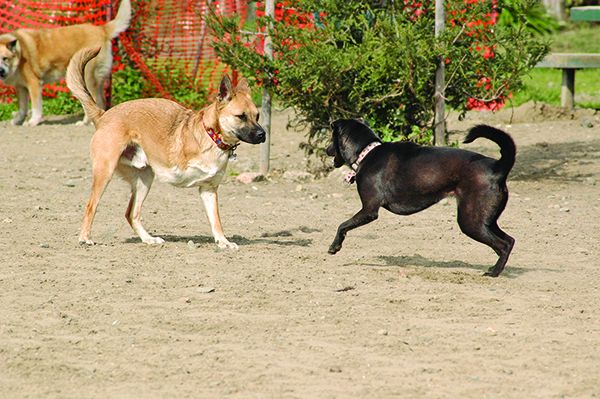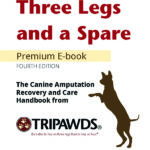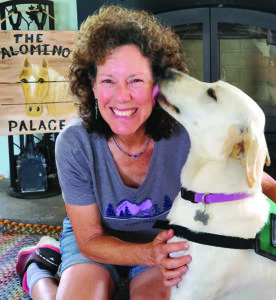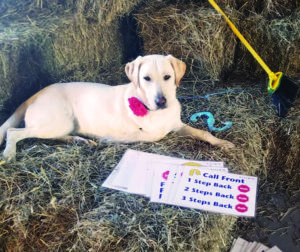
I’m not sure which is more difficult: making the decision whether or not to have your dog’s diseased or broken limb amputated, or picking up a three legged dog from the veterinarian after amputation surgery. The responsibility of making such a weighty decision for your uncomprehending dog feels terrible. So does seeing him immediately after surgery – a huge swath of him shaved to the skin, stumbling as he figures out how to ambulate in a new way – the whole thing can be shocking.
But this is the important thing to know: It gets better. The incision heals, his hair grows back, and your dog gets around just fine. The pain of whatever had to be amputated – a terribly broken bone, severed nerves, or cancer – is now gone. Typically, after surgery, three legged dogs perk up more by the day, making their owners realize that the dogs’ grouchiness or lack of enthusiasm was likely caused by tremendous pain prior to surgery. With the problematic limb gone, they feel better!
PRESERVE, DON’T OVERPROTECT
That doesn’t mean all of your troubles are over, however. The fact that amputees feel so much better can actually cause them to hurt themselves as they try to run, jump, and play with the energy and enthusiasm they had before the event that precipitated surgery – only now, they have one fewer limb to help them carry their weight and maintain their balance.
Those three remaining limbs require a bit more consideration and care, because a dog can’t really spare any more! (While there are dogs who cope with the loss of two limbs, and everything in this article is applicable to them, fortunately the need for this is rare.)
Don’t get me wrong: Three-legged dogs can still run, jump, and play; you just need to provide a little supervision and judgment, to ensure they don’t overdo it. Dogs are just not that good at anticipating potential consequences of their enthusiastic physical antics!
It’s up to you to determine whether it’s too icy or if that muddy field is too slippery for them to be playing chase games with another dog. Jumping should be kept to safe, modest heights and limited in number. If they were super-fit athletes before surgery, accustomed to accompanying their owners on long jogs or off-leash hikes, their mileage should be reduced a bit.
The single most important thing you can do to preserve your tripod dog is to keep him thin. I know, we say that about all dogs! But it’s especially true for these dogs.
There is a very human tendency to feel a bit sorry for handicapped dogs, and, perhaps subconsciously, try to “make it up to them” with a bit more food, a few more treats. Don’t! The best way to care for these dogs is to ensure that they stay skinny throughout their lifetime. This will help prevent injuries in the amputee’s remaining limbs and preserve his flexibility and mobility.
The battle against excess weight is one you can’t afford to lose, so enlist all the help you can get. If you keep reducing your dog’s food portions and he doesn’t seem to lose any weight, talk to your veterinarian. She may be able to recommend diets that are more appropriate for weight loss and lean-body maintenance than the products you are feeding.
A THREE LEGGED DOG MEANS THAT EACH LEG CARRIES MORE
When a dog loses a limb, each of his other limbs has to carry more of his weight. The burden increases the most for the remaining leg on the same end of the dog as the amputated limb.
Dogs carry about 60% of their weight on their front end. If you could compel a dog to stand with each foot on a separate scale, you’d find each front limb holding up about 30% of their body weight apiece, and each hind leg holding up about 20% of their body weight. So, do the math: If one front limb is removed, the remaining front leg has to hold up a whopping 60% of the dog’s body weight by itself! If a hind leg is removed, the remaining hind limb will need to carry about 40% of the dog’s weight.
This underscores the need to keep the dog’s weight under strict control; you don’t want any of the limbs to carry any more weight than they must. These dogs should always be kept thin.
Carrying an increased percentage of the dog’s weight as he ambulates is not the only increased burden for his remaining limbs. A single front leg has to catch all his weight for a moment every time he jumps down from a car or a couch. A single hind limb has to propel the dog forward with every stride. No matter which end of the dog is missing a limb, swimming will make the remaining leg on that end have to work much harder, too.
When, due to amputation, a three legged dog results, his stance will naturally change in order to maintain balance and stability. Instead of standing with his feet arranged in a rectangle, with a foot in each corner, the limb that’s lacking a partner will start to shift toward the center of his body, so that his footprints form a triangle. This change in his stance can tweak the rest of his body – spine, neck, shoulders, and hips. For these reasons – an increased workload and a shifting stance – tripods will benefit from some specific accommodations and health interventions:
* Provide nonslip surfaces in the house. Slick floors, whether they are tile, hardwood, or laminate, are the bane of tripod dogs. Dogs who slip tend to flail and/or make quick movements to try to catch themselves – and it’s these frantic motions that are often responsible for torn muscles or ligaments. Wherever possible, provide a route with improved traction (with nonslip carpet runners or yoga mat material) for your dog through the most slippery rooms; you’ll find these will become his favorite paths. Don’t forget the stairs!
Traction socks or non-slip booties are an option for some dogs.
* Prevent your three legged dog from jumping down. If your dog is in the habit of leaping off your bed or couch, or routinely launching himself out of the car after a drive, you may be a bit skeptical about your ability to control this. But any veterinarian will tell you that the hard landing experienced in this sort of jump is one of the most destructive forces on your tripod’s body that there is. Working on a solution will be worth the effort!
When getting out of the car, block his exit and get hold of his leash. Guide him to the floor of the car, so he doesn’t jump off the much higher seat. If even the floor of your car is high, see if you can use a ramp, or lift him out of the car. In the house, provide him with “puppy stairs” (these are readily found in pet supply stores and online) or ramps, and teach him to use them with high-value reinforcements. He may still jump off the couch or bed when you’re not present to encourage the safer way, but you will have at least reduced the total number of hard landings he subjects his body to.
* Train him to walk on a loose leash. In our opinion, good leash skills are important for every dog, but they are critical for tripods. He already has to work harder to ambulate than a four-legged dog; if he is pulling against you the entire time, he’s working far too hard and in all the wrong ways. Consider a private lesson with a qualified, force-free training professional and practice! (For more information about training a dog to walk on a loose leash, see “Loose Leash Walking,” WDJ April 2017 and “Frustrated on Leash?” WDJ October 2019.)
* Bring a stroller on walks. If your dog becomes fatigued on walks, consider purchasing a dog stroller. After she rests for a bit, your dog may express an interest in getting out and walking again. This will help maintain the length of your exercise time, so your dog (and you!) don’t lose fitness by taking progressively shorter walks.
* Use joint-support supplements – right away. Again, because he has fewer legs over which to distribute his weight, the impact on his remaining joints will be greater than for a four-legged dog. This means he will be at higher risk of developing osteoarthritis.
Don’t wait for your three legged dog to develop arthritis; at that point, providing pain relief is about all you can do. Joint supplements will help prevent, slow, or delay the development of arthritis, which is far better than waiting until the disease is established.
Adequan is the only FDA-approved disease-modifying osteoarthritis drug that has been proven to inhibit cartilage loss in a dog’s joints, thus helping prevent or stave off the development of osteoarthritis. It’s available only with a veterinarian’s prescription and administered as a series of intramuscular injections, twice weekly for up to four weeks. Usually, your vet will administer the first dose; if you think you’re able to inject the next doses, your vet will show you how. If not, most clinics will have a technician deliver the rest of your dog’s doses.
The array of oral over-the-counter dietary joint-health supplements on the market is overwhelming. These may contain glycosaminoglycans (GAGs) such as glucosamine and chondroitin. Herbal supplements containing turmeric, boswellia, and/or devil’s claw have been shown to reduce joint pain caused by osteoarthritis. Fish oil, which contains the omega-3 fatty acids docosahexaenoic acid (DHA) and eicosapentaenoic acid (EPA), has been shown to have anti-inflammatory effects, as have green-lipped mussels. Ask your vet for product recommendations and therapeutic dosages for your dog.
* Provide physical therapy. The value of physical therapy for three legged dogs cannot be overstated. The goal is multi-pronged:
• To relieve pain from over-tight muscles
• To support and maintain joint range-of-motion
• To stimulate and improve circulation, which promotes healing and health
• To gently warm up and stretch muscles, ligaments, and tendons before and after exercise
• To detect soreness that might escalate into an injury if the dog’s exercise is not modified
• To improve the dog’s balance and muscle control
Even a single consultation with a veterinary physical therapist is valuable. These specialists can detect subtle gait or posture problems or adaptations that your three legged dog has made following his amputation. They will then prescribe specific stretching and strengthening exercises and teach you how to do them with your dog. Some therapists also use massage, laser therapy, and exercises in therapy pools and underwater treadmills. Ask your veterinarian for a referral.
* Consider complementary therapies such as chiropractic and acupuncture. Both of these modalities can help relieve pain and keep the joints free and the muscles loose.
* Provide pain relief as needed. Your veterinarian is a critical partner in this essential task.

* Last but not least: You must check out tripawds.com. This exhaustive website is a clearinghouse for information about amputation (as well as the many health conditions that necessitate this surgery) and caring for three legged dogs (and cats). The site also hosts blogs and supportive discussion forums for owners. Perhaps the most valuable resource are the books and ebooks published by Tripawds, containing countless links and references for further information.
Related Articles
The Difficult Decision to Amputate Your Dog’s Leg

We asked followers of the WDJ Facebook page if they had a tripod dog and if so, what supportive care they use to preserve their dog’s soundness and mobility. We received a number of informative responses, but person who shared her dog’s journey just flattened us. Trainer Carolyn Baynes of Ellendale, Delaware, wrote:
“I rescued a 6-week-old pup with a twisted leg. I thought the leg was broken, but vets confirmed severe nerve damage in the pup’s shoulder. At 10 weeks, her right leg and scapula were amputated. Ari handled recovery with courage and strength that I never could have imagined. She told me, ‘I’m OK Mom, let’s get going!’
“Within 18 months, Ari has earned AKC Star Puppy, AKC Canine Good Citizen (CGC), and AKC Novice and Intermediate Trick Dog Titles. She is a Registered National Capital Therapy Dog and is the ‘spokescanine’ behind AKC’s decision to allow three-legged dogs to compete in Virtual Obedience effective March 1, 2021!

“To keep Ari healthy, I keep her weight down, work with core-strengthening exercises several times a week using a wobble board, travel board, exercise ball, etc. Ari swims beautifully and climbs the hay bales in the barn without effort, which also helps to keep her strong. I feed her human-grade food with a fish-oil supplement and a glucosamine/chondroitin supplement.”
Ari is accomplished at rally obedience and recently started learning barn hunt skills and scent work. Don’t miss the photo of Ari and Carolyn’s chocolate Labrador Chayce, who are featured on the cover of this issue, as they participated in a presentation of National Capital Therapy Dogs.






My 10 year old Berner lost his front leg to cancer 1 1/2 years ago. All of your advice is solid. The Tripawd website is invaluable, you will find nothing support and positive messages. It useful for those who are in the process of making the decision to have the surgery as well. Anyone who has had to make this decision knows that the 1st two weeks are incredibly difficult and most of us say that at some point they question whether they have made the right decision. Pain management, time, weight management, a good harness and you will get your puppy back. Looking back we now realize how much pain he was in until he recovered from surgery. Dogs are resilient and Moose has taught us to not look back and live in the moment.
My tripawd dog is missing one of his front legs and can’t hold dental chews in his remaining paw. Does anyone know of a chew or something that he might be able to eat to help his dental care. I do put additive in his water.
My vet hasn’t been any help at all. She thinks I am making excuses for him.
You could use a chip bag clip for smaller dog.clamps for bigger ones…